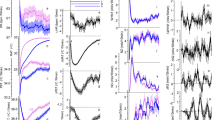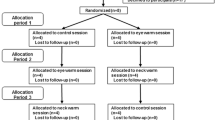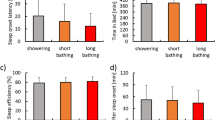Abstract.
The purpose of this study was to confirm the effect of head cooling on human sleep stages and body temperature. Nine healthy male volunteers with a mean age of 25 ± 3.77 years served as subjects. The experiments were carried out under three different sets of conditions: 26 °C, relative humidity (RH) 50% (26/50); 32 °C, RH 80% (32/80); and 32 °C RH 80% with the use of a cooling pillow (32/80 HC). The subjects slept from 2300 hours to 0700 hours with a cotton blanket, wearing short-sleeved pyjamas and shorts on a bed, which was covered with a sheet. Electroencephalograms, electro-ouclogram, and mental electromyelograms were recorded through the night. Rectal temperature (T re) and skin temperature (T sk) were measured continuously. Whole-body sweat and the tympanic temperature (T ty) were measured before and after sleep. Wakefulness significantly increased at 32/80 than at 26/50; however, no significant difference was observed between 32/80 HC and 26/50. T re and mean T sk were higher both at 32/80 and 32/80 HC than at 26/50. The whole-body sweat loss was significantly greater and T ty in the morning was higher at 32/80 than 32/80 HC and 26/50. These results suggest that head cooling during sleep may help to decrease the whole-body sweat rate during sleep under humid heat conditions.



Similar content being viewed by others
References
Amoros C, Sagot JC, Libert JP, Candas V (1986) Sweat gland response to local heating during sleep in man. J Physiol (Paris) 81:209–215
Baker MA (1979) A brain-cooling system in mammals. Sci Am 240:130–139
Barret J, Lack L, Morris M (1993) The sleep evoked decrease of body temperature. Sleep 16:93–99
Brengelmann GL (1993) Specialised brain cooling in humans? FASEB J 7:1148–1153
Brinnel H, Cabanac M (1989) Tympanic temperature is a core temperature. J Therm Biol 14:47–53
Cabanac M (1993) Selective brain cooling in humans: "fancy" or fact? FASEB J 7:1146–1147
Cabanac M, Caputa M (1979) Natural selective cooling of the human brain: evidence of its occurrence and magnitude. J Physiol (Lond) 286:255–264
Candas V, Libert JP, Muzet A (1982) Heating and cooling stimulations during SWS and REM sleep in man. J Therm Biol 7:155–158
Cohen JB, Allan JR, Sowood PJ (1989) Effects of head or neck cooling used with a liquid conditioned vest during simulated aircraft sorties. Aviat Space Environ Med 60:315–320
Crawshaw LI, Nadel ER, Stolwiji JA, Stamford BA (1975) Effect of local cooling on sweating rate and cold sensation. Pflugers Arch 354:19–27
Desruelle AV, Candas V (2000) Thermoregulatory effects of three different types of head cooling in humans during a mild hyperthermia. Eur J Appl Physiol 81:33–39
Froese G, Burton A (1957) Heat loss from the human head. J Appl Physiol 10:235–241
Greenlear JE, Beaumont WV, Brock PJ, Montgomery LD, Morse JT, Shvartz E, Kravik S (1980) Fluid electrolyte shifts and thermoregulation: rest and work in heat with head cooling. Aviat Space Environ Med 51:747–753
Haskell EH, Palca JW, Walker JM, Berger RJ, Heller HC (1981) The effects of high and low ambient temperatures on human sleep stages. Electroencephalogr Clin Neurophysiol 51:494–501
Horne JA, Ostberg OA (1976) self-assessment questionnaire to determine morningness-eveningness in human circadian rhythms. Int J Chronobiol 4:97–110
Jessen C, Kuhnen G (1992) No evidence for brain stem cooling during a face fanning in humans. J Appl Physiol 72:664–669
Kawabata A, Tokura H (1996) Effects of two kinds of pillow on thermoregulatory responses during night sleep. Appl Hum Sci 15:155–159
Libert JP, Candas V, Muzet A, Ehrhart J (1982) Thermoregulatory adjustments to thermal transients during slow wave sleep and REM sleep in man. J Physiol (Paris) 78:251–257
MacCaffrey TV, Geis GS, Chung JM, Wurster RD (1975a) Effect of isolated head heating and cooling on sweating in man. Aviat Space Environ Med 46:1353–1357
MacCaffrey TV, McCook RD, Wurster RD (1975b) Effects of head skin temperature on tympanic and oral temperatures in man. J Appl Physiol 39:114–118
Nielsen B, Jessen C (1992) Evidence against brain stem cooling by face fannning in severly hyperthermic humans. Pflugers Arch 422:168–172
Nunneley SA, Maldonado RJ (1983) Head and or/torso cooling during simulated cockpit heat stress. Aviat Space Environ Med 54:496–499
Nunneley SA, Reader DC, Maldonado RJ (1982) Head-temperature effects on physiology, comfort and performance during hyperthermia. Aviat Space Environ Med 53:623–628
Ogawa T, Satoh T, Takagi K (1967) Sweating during night sleep. Jpn J Physiol 17:135–136
Ogawa T, Sugenoya J, Ohnishi N, Natsume K, Imai K, Kandori Y, Ishizuka A, Osada A (1993) Effects of body and head positions on bilateral difference in tympanic temperatures. Eur J Appl Physiol 67:354–359
Okamoto-Mizuno K, Mizuno K, Michie S, Maeda A, Iizuka S (1999) Effects of humid heat exposure on human sleep stages and body temperature. Sleep 22:767–773
Parmeggiani PL (1987) Interaction between sleep and thermoregulation: an aspect of the control of behavioural states. Sleep 10:426–435
Ramanathan NI (1964) A new weighting system for mean surface temperature of the human body. J Appl Physiol 19:531–533
Rasch WP, Samson J, Cote J, Cabanac M (1991) Heat loss from the human head during exercise. J Appl Physiol 71: 590–595
Reftshaffen A, Kales A (1968) A manual of standardised terminology. Technique and scoring system for sleep stages of human subjects. Public Health service, US Government Printing Office
Sagot JC, Amoros C, Candas V, Libert JP (1987) Sweating responses and body temperatures during nocturnal sleep in humans. Am J Appl Physiol 252:R462–R470
Sakaguchi S, Glotzbach SF, Heller HC (1979) Influence of hypothlamic and ambient temperatures on sleep in kangaroo rats. Am J Physiol 237:80–88
Acknowledgements.
This study was supported by Special Coodination Funds of the Ministry of Education, Culture, Sports, Science and Technology, the Japanese Government.
Author information
Authors and Affiliations
Corresponding author
Rights and permissions
About this article
Cite this article
Okamoto-Mizuno, K., Tsuzuki, K. & Mizuno, K. Effects of head cooling on human sleep stages and body temperature. Int J Biometeorol 48, 98–102 (2003). https://doi.org/10.1007/s00484-003-0181-3
Received:
Revised:
Accepted:
Published:
Issue Date:
DOI: https://doi.org/10.1007/s00484-003-0181-3




